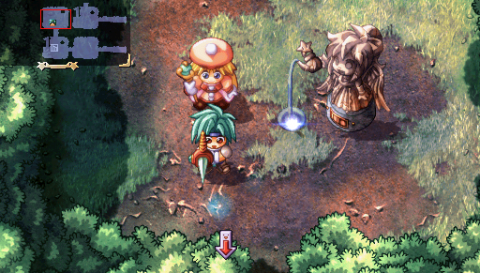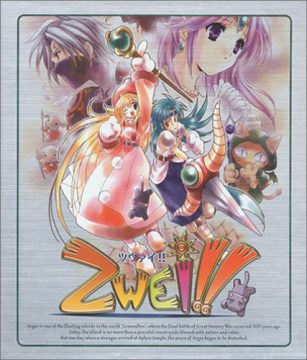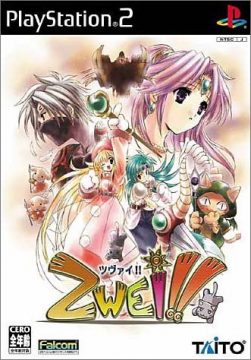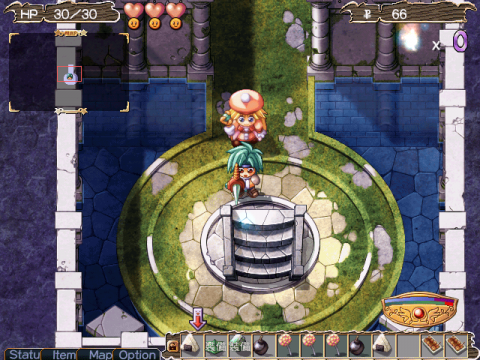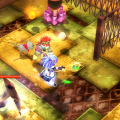- Zwei: The Arges Adventure
The genre term “dungeon crawler” comes from a specific kind of RPGs which involves, suitably enough, crawling dungeons. They typically tend to be dank games, because what does a dungeon suggest, if not dankness? So it’s a rare game that takes the fundamentals of the genre and does something much brighter with it. Such games are the Zwei!! series, from Falcom. The name – German for “two” – comes from there being two playable characters, which can be switched between at any time. (Oddly, there is no multiplayer option.) The exclamation points in the Japanese titles are for emphasis, as if the title is to be shouted, highlighting that these are fun, silly little games.
Zwei!! takes place in the world of Granvallen, a series of land masses floating high in the sky. Pipiro and Pokkle are two kids living in the village of Puck, locating on the continent of Arges. As the story begins, a masked man has broken into the village shrine and steals six Goddess statues. Although his purpose in initially shrouded in mystery, this figure ultimately intends to resurrect the dark lord Vesper, who had been previously defeated centuries ago. Pipiro and Pokkle decide to take up arms and explore the dungeons of the continent, recovering the statues and saving the world.
Characters
Pipiro
Pipolo is meant to take on the role of the Legendary Shrine Maiden Princess Tiara, but even though she’s incredibly talented in magic, she’s more interested in fashion and eating sweet desserts. Since she’s older than Pokkle (only by a month), she’s also a little bit wiser.
Pokkle
Pokkle is Pipolo’s brother-in-law. He’s a talented fighter, who is also extremely good at housework and has a fondness for bad puns and other terrible jokes. He has an odd relationship with Pipolo since he greatly admires his older sister, and views Pipolo’s brother as having stolen her away. But despite holding that grudge, they still get along pretty well. He also has a tail – he’s not part animal or anything, he just likes to wear it.
The entire adventure never leaves the land of Arges, which consists of Puck Village and seven other major locales. However, each location consists of several maze-like dungeons. These are indicated with a suggested experience level, however, you can always enter underleveled (though isn’t advised), and some can be skipped. However, higher level dungeons require items that can only be found by exploring lower level areas, requiring you to double back to prior areas, so ultimately it’s still fairly linear. There are regular rest spots where you can recharge your health and save your game.
The combat is very simplistic. Pokkle uses physical moves, and automatically leaps toward any enemy in range when you hit the attack button, while Pipiro uses ranged attacks that also home in towards an enemy. Continued hits will send enemies flying into the air, where they can be juggled until they’re killed. If you manage to create high enough combos by consistently hitting enemies, you’ll also build up stock that can be used for more powerful charge attacks. There are various magic gems to find, which will change Pipilo’s magic to one of six different types of elemental affinities, and can be used to deal extra damage if you pay attention to them. Once you get far enough in the game, you can even do combos with both characters. There is also a metronome-like meter at the bottom of the screen which bounces back and forth in a quick rhythm. If you attack right as the meter is in its center, you’ll land a critical hit. You can also bring along a pet, with the choice of either a dog or cat. They’ll follow you around the dungeon and pick up stuff, and can aid in combo attacks.
Zwei‘s most innovative aspect lies in its experience system. Most fallen enemies will drop an assortment of food items – these not only restore health, but consuming them is the only way to gain experience points. If you manage to collect 10 of a certain item, they can be exchanged back in the village for another single higher level item. This will grant both more health and experience (by a factor of 1.5x) than if you had consumed 10 of the lesser items separately. This encourages you to minimize damage and squirrel away as many food items as possible for when you return to the village, since it will let you upgrade your characters faster.
But Zwei’s charm lies not its in mechanics but in its aesthetics. It’s an insanely cute, bubbly little game – even the dark areas like underground ruins and caves are relatively colorful. Only the bosses are made of polygons, but otherwise everything is 2D. It runs in 640×480 SVGA, making for some incredibly detailed pixel artwork, even if it seems low compared to today’s 4k resolutions. It’s not just in the artistic quality, it’s in all of the little things that make the game positively adorable, like the rapidly clambering footsteps of the main characters (they can be turned off if they get annoying), the referee whistle sound effect when you switch characters, the bouncy animations of Pipolo and Pokkle, or the diary that Pipolo keeps that re-illustrates all major plot events as crayon scribblings.
Pipolo and Pokkle also has a unique relationship, the type rarely seen in most RPGs. Even though they’re not brother and sister by blood, they act like they are, jabbing at each other playfully and generally goofing around. Pokkle has a thing for the ladies and a fondness for excruciating puns, while Pipolo is almost pure sass.
As usual for Falcom games, the soundtrack is fantastic. A far cry from the rock driven tracks of Ys, Zwei‘s music is instead very calming, with its main overworld theme played on acoustic guitar and flutes. Much of it is reminiscent of Yasunori Mitsuda’s work on Chrono Cross, which is a compliment of the highest order.
However, it must again be emphasized that most of the enjoyment of this game comes from the writing, as well as how it looks and sounds – from a pure gameplay perspective, it’s rather average. The combat is simple, and the puzzles, as much as one can call them that, just revolve around hitting switches or moving statues. There’s very little in the way of equipment, other than some small stat modifying objects, and most of the loot you grab consists of food.
And despite the high quality of the graphics, the level designs do get really repetitive. The towns and the entrances are drawn in extravagant detail, but once you get into the dungeons, they consist of the same tilesets over and over. The levels aren’t randomly generated, but certainly it feels like they are. You bounce back and forth between the areas, usually every few dungeons, so you never have to spend too long in one area at a time, but other than the occasional boss battle, there’s not much to break up the monotony. Still, the dungeons are rarely very long, so it’s easily consumable in small bites.
From the perspective of an expert dungeon crawler fan, Zwei might seem shallow. Even admiring it for its cuteness and personality, there’s not really enough substance to keep it going through all 50-or-so levels, unless the completionist in you really wants to fill out the game’s database, and the fighting isn’t all that satisfying. It’s still worth playing though, at least to admire how good it looks and to laugh at the silly characters, and the soundtrack album is required listening for any video game music fan.
Included with the Windows version are some desktop accessories. Most of these are standard calendars, clock, and calculator applications, but there’s also a Pet Monitor, a simple adventure game that works in tandem with your pet from the main game. Though you can make choices at certain intervals, it can also play by itself. As you progress, the pet can grow stronger and find new items to help you out.
There are also a few mini-games. Zwei!! Shooting is a simple side-scrolling shoot-em-up. Typing of the Ys is a typing tutor where you control Adol and beat up enemies, based on how your typing skill. And Mona Mona is a falling block puzzle game featuring the mascot bunny from Falcom’s Monarch Monarch strategy game.
The PlayStation 2 version, ported and published by Taito, is a very good port, surprising considering the middling quality of other PC-to-PS2 Falcom games like Ys I & II Eternal and VM Japan. The visuals aren’t as nice due to television interlacing, but otherwise have been translated perfectly. The only real change is that some of the optional dungeons towards the end of the game have become mandatory, though they have been rebalanced to be slightly easier. The typing minigame, as well as the desktop accessories, are also gone.
The PSP version was released in 2009, eight years after the original, presumably due to Falcom’s success on the platform with their other ports like Sora no Kiseki / Trails in the Sky. The PSP resolution can’t quite handle the original graphics (480×272 of the PSP versus 640×480 of the SVGA Japanese Windows), so the graphics have lost some of their detail, and they’re not nearly as sharp. However, the playing field has been zoomed out, and the view adapted for widescreen. Outside of some brief loading times, it also runs very well.
Some new character artwork has been added to make it more consistent with the sequel, as well as an option for a newly arranged soundtrack and some added voice samples. Like most games that feature redone music, the quality of the tracks is inconsistent – some are excellent and benefit from the redone instrumentation, while others sound slightly worse. It’s also missing the Mona Mona minigame along with Typing of the Ys.
In 2018, XSeed translated Zwei!! into English, giving it the subtitle The Arges Adventure. Due to development, it was actually published a few months after their release of the second Zwei. Beyond translating into English (with a fantastic script), many of the additions are technical – better functionality with modern Windows system, widescreen view, and some improved UI options as well as far better gamepad support. It also adds the ability to choose between the regular OST and the arranged version created for the PSP port. Most of the apps have been integrated into the game UI, though for technical reasons, the calender and calculator were disabled. However, since the appearance of an optional boss required obtaining these, two different items (a clock warranty and manual) were added in its place. Also included are additional, newly drawn bromides as well as new tutorial screens, bringing it up to standard with other, more modern Falcom games. All of the minigames are also available from the start rather than being unlocked, showing up in the arcade in town.
Links
Shinju Forest A love letter to Zwei!! (Some pics taken from here)
Zwei!! Official Website Translation
Screenshot Comparisons

